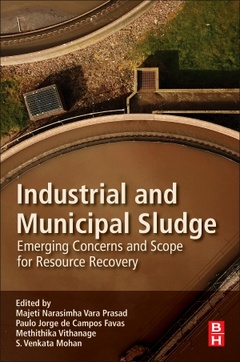Industrial and Municipal Sludge Emerging Concerns and Scope for Resource Recovery
Coordonnateurs : Vara Prasad Majeti Narasimha, de Campos Favas Paulo Jorge, Vithanage Meththika, Mohan S.Venkata

Industrial and Municipal Sludge: Emerging Concerns and Scope for Resource Recovery begins with a characterization of the types of sludge and their sources and management strategies. This section is followed by specific chapters that cover Emerging contaminants in sludge (Endocrine disruptors, Pesticides and Pharmaceutical residues, including illicit drugs/controlled substances), Bioleaching of sludge [with an enriched sulfur-oxidizing bacterial community, Recovery of valuable metals (Bioleaching and use of sulfur-oxidizing bacterial community, and Biogas production by continuous thermal hydrolysis and thermophilic anaerobic digestion of waste activated sludge. In addition, the book includes numerous tables and flow diagrams to help users further comprehend the subject matter.
Section 1: Sludge: Sources and Characterization1. Sludge from waste water treatment plants2. Sludge from pulp, tannery and distillery industries3. Sludge from oil refinery4. Sludge from chemical industry5. Sludge from antibiotic wastewater treatment plants- Fate of antibiotic resistance 6. Earthworms converting milk processing industry sludge into biomanure
Section 2: Sludge Management7. Activation, conditioning and engineering of sludge8. General considerations on sludge disposal 9. Sludge legislation (comparison between different countries)10. Enhanced sludge degradation process using a microbial electrolysis cell11. Sludge dewatering - Processes for enhanced performance12. Rheological characterization of digested sludge
Section 3: Contaminants in Sludge and Treatment strategies13. Ecological and human health risks (general aspects of sludge ecotoxicity and public health)14. Emerging contaminants in sludge (Endocrine disruptors, Pesticides and Pharmaceutical residues, including illicit drugs/controlled substances, etc.)15. Traditional contaminants in sludge (Poly Aromatic Hydrocarbons (PAH) and Poly Chlorinated Biphenyls (PCBs), dioxins, perfluorinated chemicals, alkylphenol surfactants, etc.)16. Bioleaching of sludge [with an enriched sulfur-oxidizing bacterial community]17. Sludge as medium for degradation of textile industry effluents
Section 4: Valorization of Sludge as a Resource18. Fertilizer for agriculture/ Manure for agro-forestry Sludge ash to horticultural crops19. Sludge multifunctions in a phytobiome – (Forest and plantation application incl. microbial aspects)20. Co-composting of sewage sludge and wetland plant material from a constructed wetland treating domestic wastewater21. Biochar production from sludge22. Phosphorus extraction and sludge dissolution23. Recovery of valuable metals from sludge (Bioleaching and use of sulfur-oxidizing bacterial community)24. Water-based paint sludge from automotive industries
Section 5: Energy recovery from sludge25. Co-processing of sewage sludge in cement kiln26. Biorefinery-based valorisation of pulp and paper sludge - opportunities and challenges27. Volatile fatty acid yield from sludge anaerobic fermentation through biotechnological approach28. Biogas (methane production) and energy recovery from different sludges 29. Biogas production by continuous thermal hydrolysis and thermophilic anaerobic digestion of waste activated sludge 30. Sewage Sludge based Microbial fuel cell
Dr De Campos Favas is a professor in the Department of Geology of the University of Trás-os-Montes e Alto Douro as well as a member of the Marine and Environmental Sciences Centre (MARE) from the University of Coimbra. He has been involved in 10 research projects. He is author and co-author of 29 peer-reviewed papers in scientific journals and 136 papers in conference proceedings, has 19 book chapters and 2 books published. His main areas of research are: heavy metals and arsenic contamination (soil, sediment, water); acid mine drainage; bioaccumulation of metals in plants (aquatic and terrestrial environments); hyperaccumulator plants; phytoremediation; bioindication; restoration of degraded mine areas.
She is the leader of the Ecosphere Resilience Research Center, Faculty of Applied Science at the University of Sri Jayewardenepura, Sri Lanka, Visiting Associate Research Professor, National Institute of Fundamental Studies, Sri Lanka and an Adjunct Associate Research Professor at the University of Southern Queensland, Australia. Dr. Vithanage’s research approach builds on enabling measurements of concentrations and reaction rates in environmental samples for key/emerging pollutants in the environment in order to assess their fate and transport to discover so
- Includes numerous tables and flow diagrams to assist in the comprehension of new and existing sludge treatments and resource recovery technology
- Covers biogas production by continuous thermal hydrolysis and thermophilic anaerobic digestion of waste activated sludge
- Presents information on the recovery of valuable metals from sludge (bioleaching and the use of a sulfur-oxidizing bacterial community)
- Includes opportunities and challenges in the biorefinery-based valorization of pulp and paper sludge
Date de parution : 04-2019
Ouvrage de 856 p.
15.2x22.8 cm



